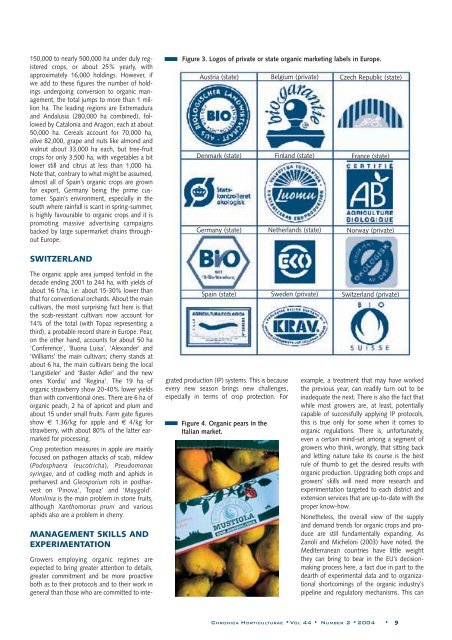Number 2 - 2004 - Acta Horticulturae
Number 2 - 2004 - Acta Horticulturae
Number 2 - 2004 - Acta Horticulturae
You also want an ePaper? Increase the reach of your titles
YUMPU automatically turns print PDFs into web optimized ePapers that Google loves.
150,000 to nearly 500,000 ha under duly registered<br />
crops, or about 25% yearly, with<br />
approximately 16,000 holdings. However, if<br />
we add to these figures the number of holdings<br />
undergoing conversion to organic management,<br />
the total jumps to more than 1 million<br />
ha. The leading regions are Extremadura<br />
and Andalusia (280,000 ha combined), followed<br />
by Catalonia and Aragon, each at about<br />
50,000 ha. Cereals account for 70,000 ha,<br />
olive 82,000, grape and nuts like almond and<br />
walnut about 33,000 ha each, but tree-fruit<br />
crops for only 3,500 ha, with vegetables a bit<br />
lower still and citrus at less than 1,000 ha.<br />
Note that, contrary to what might be assumed,<br />
almost all of Spain’s organic crops are grown<br />
for export, Germany being the prime customer.<br />
Spain’s environment, especially in the<br />
south where rainfall is scant in spring-summer,<br />
is highly favourable to organic crops and it is<br />
promoting massive advertising campaigns<br />
backed by large supermarket chains throughout<br />
Europe.<br />
Figure 3. Logos of private or state organic marketing labels in Europe.<br />
Austria (state) Belgium (private) Czech Republic (state)<br />
Denmark (state) Finland (state) France (state)<br />
Germany (state) Netherlands (state) Norway (private)<br />
SWITZERLAND<br />
The organic apple area jumped tenfold in the<br />
decade ending 2001 to 244 ha, with yields of<br />
about 16 t/ha, i.e. about 15-30% lower than<br />
that for conventional orchards. About the main<br />
cultivars, the most surprising fact here is that<br />
the scab-resistant cultivars now account for<br />
14% of the total (with Topaz representing a<br />
third), a probable record share in Europe. Pear,<br />
on the other hand, accounts for about 50 ha<br />
‘Conference’, ‘Buona Luisa’, ‘Alexander’ and<br />
‘Williams’ the main cultivars; cherry stands at<br />
about 6 ha, the main cultivars being the local<br />
‘Langstieler’ and ‘Baster Adler’ and the new<br />
ones ‘Kordia’ and ‘Regina’. The 19 ha of<br />
organic strawberry show 20-40% lower yields<br />
than with conventional ones. There are 6 ha of<br />
organic peach, 2 ha of apricot and plum and<br />
about 15 under small fruits. Farm gate figures<br />
show € 1.36/kg for apple and € 4/kg for<br />
strawberry, with about 80% of the latter earmarked<br />
for processing.<br />
Crop protection measures in apple are mainly<br />
focused on pathogen attacks of scab, mildew<br />
(Podosphaera leucotricha), Pseudomonas<br />
syringae, and of codling moth and aphids in<br />
preharvest and Gleosporium rots in postharvest<br />
on ‘Pinova’, Topaz’ and ‘Maygold’.<br />
Monilinia is the main problem in stone fruits,<br />
although Xanthomonas pruni and various<br />
aphids also are a problem in cherry.<br />
MANAGEMENT SKILLS AND<br />
EXPERIMENTATION<br />
Spain (state) Sweden (private) Switzerland (private)<br />
Growers employing organic regimes are<br />
expected to bring greater attention to details,<br />
greater commitment and be more proactive<br />
both as to their protocols and to their work in<br />
general than those who are committed to integrated<br />
production (IP) systems. This is because<br />
every new season brings new challenges,<br />
especially in terms of crop protection. For<br />
Figure 4. Organic pears in the<br />
Italian market.<br />
example, a treatment that may have worked<br />
the previous year, can readily turn out to be<br />
inadequate the next. There is also the fact that<br />
while most growers are, at least, potentially<br />
capable of successfully applying IP protocols,<br />
this is true only for some when it comes to<br />
organic regulations. There is, unfortunately,<br />
even a certain mind-set among a segment of<br />
growers who think, wrongly, that sitting back<br />
and letting nature take its course is the best<br />
rule of thumb to get the desired results with<br />
organic production. Upgrading both crops and<br />
growers’ skills will need more research and<br />
experimentation targeted to each district and<br />
extension services that are up-to-date with the<br />
proper know-how.<br />
Nonetheless, the overall view of the supply<br />
and demand trends for organic crops and produce<br />
are still fundamentally expanding. As<br />
Zanoli and Micheloni (2003) have noted, the<br />
Mediterranean countries have little weight<br />
they can bring to bear in the EU’s decisionmaking<br />
process here, a fact due in part to the<br />
dearth of experimental data and to organizational<br />
shortcomings of the organic industry’s<br />
pipeline and regulatory mechanisms. This can<br />
CHRONICA HORTICULTURAE •VOL 44 • NUMBER 2 • <strong>2004</strong> • 9
















